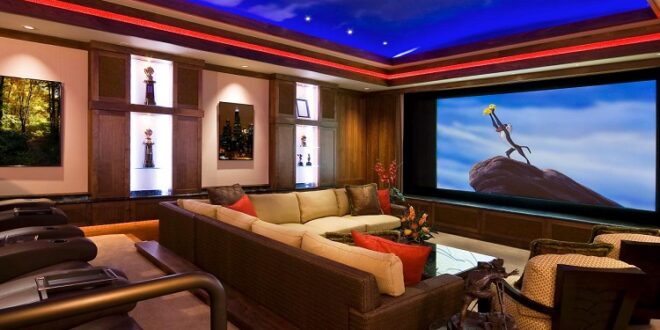All over the USA, people have spent the last year busily engaged in home improvement projects. Surveys suggest that as many as three in four homeowners have taken on at least one project in recent times, and have a few more planned.
Have you run out of ideas to make your home a better place? Why not go all out by setting up a home theater room for non-stop at-home entertainment?
Start planning the ultimate home theater setup with these top tips.
Find a Space For Your Home Movie Theater
You can set up your living room so that one command to Alexa transforms it into a home theater, and that’s great. Yet, it’s not quite the same as having a dedicated space for your entertainment, when you have a family who’s constantly sparring over the remote.
A spare room or basement’s the ideal location for your home theater but you’ll need to do some work to get it up to scratch. Ideally, you want to choose a room that’s long enough to provide a proper distance between viewers and the screen.
For instance, you’ll need a 14-foot throw distance from your projector to your screen. Even without a projector, you want to avoid viewers straining their necks at an uncomfortable angle while enjoying the show.
Set Up Ideal Conditions for Light and Sound
Ambient light and sound detract from the home theater experience. So, you should do as much as you can to mitigate these factors before you start work on your home theater.
Most rooms have light streaming in from outside, which makes your basement a better choice when it comes to limiting light. If the basement’s off-limits, you can block natural light using blackout shades and curtains.
Home are noisy places, and you’ll need to take steps to eliminate these sounds from intruding on the viewing experience.
You can soundproof your room by adding an extra layer of drywall or specialized sound-reducing wallboard inside your room. Replacing hollow-core doors with solid ones also helps, as do thicker curtains.
Once you’ve secured your room against these outside distractions, paint it with dark-colored non-reflective paint. Don’t forget the ceiling, white paint’s a bad choice for theaters. Rather opt for the same tone as your walls, or pick a dark gray hue for the ceiling.
Wall to wall carpet’s the best solution to prevent sound and light bouncing around the room.
Build a Great A/V Component Rack
A great AV rack is the hub of your viewing pleasure where you control all the entertainment-related activities in your theater. All the source components, like your cable ox, network streaming box, tuner, and Blu-ray player, operate from there.
Step one is placing your A/V rack close to an electric outlet and internet source wire. You don’t want unsightly cables stretching across your room.
Next, make sure that the rack’s well ventilated. Tech equipment creates heat and if this builds up it can cause problems. Your A/V rack should have an open back and front and be sturdy enough to manage the weight of all your devices.
Design Your Theater Interior
Most of us think of velvet curtains and dark gilt-bedecked spaces when we visualize a home theater. Yet, there are no hard-and-fast rules when it comes to designing your theater.
Rather focus on coming up with home theater room ideas that suit your tastes and needs.
You should bear the basic concepts of theater design in mind though, there are good reasons for these classic setups. Seating is one of the main components of theater design.
It’s easy to build platforms for your theater seating out of sturdy wooden boards and conceal them with carpet. Avoid making changes to your room before you’ve decided on how to furnish and decorate your room.
Furnish Your Home Theater Room
A suitable AV system and screen are the top considerations for any A/V room. A drop-down screen and projector work best but you can opt for the largest flat-screen TV you can afford instead.
The next most important item is your seating. These helpful seating ideas can get you started finding the ideal seats and setup. If your budget doesn’t extend as far as state-of-the-art theater seating, you can opt for comfy couches instead.
Once you’ve worked out the layout of your seating, you can start work on raised platforms and other options to optimize your viewing.
Keep your decorating aspirations low-key. Any colorful posters, artwork, and decorations placed too close to the screen detract from the viewing experience.
Rather, place your awesome movie poster collection, popcorn machine, and refreshment station at the back of the theater behind the seats.
Plan the Best Home Theater Lighting and Sound
When you’ve got your seating in place you can plan your lighting and sound accordingly.
The ability to dim the lights is a key component of any home theater system. Some of the best options for lighting in a home setting include recessed lighting, soffit lights, and rope lights.
Set up most of the lights behind the viewer, and they should all face down to avoid degrading the experience.
Work Out the Best Data Flow
Although most home entertainment arrives via streaming nowadays, there are still plenty of wires involved in running home theater systems.
Avoid a tangled mess by hiding necessary wires in soffits, behind drywall, or with cord covers. Of course, remote solutions like Bluetooth are always preferable for home theater speakers and data streaming.
Need Some More Ideas?
If you don’t have the space for a home theater room, there are plenty of simple ways to upgrade your home without excessive effort and expense.
Simple things like decluttering, painting, and basic repairs go a long way toward improving your home’s livability and appearance. Keep browsing our blog to find inspiration for your home improvement projects.
 HammBurg Be informed with latest news, reviews, entertainment, lifestyle tips, and much more.
HammBurg Be informed with latest news, reviews, entertainment, lifestyle tips, and much more.




